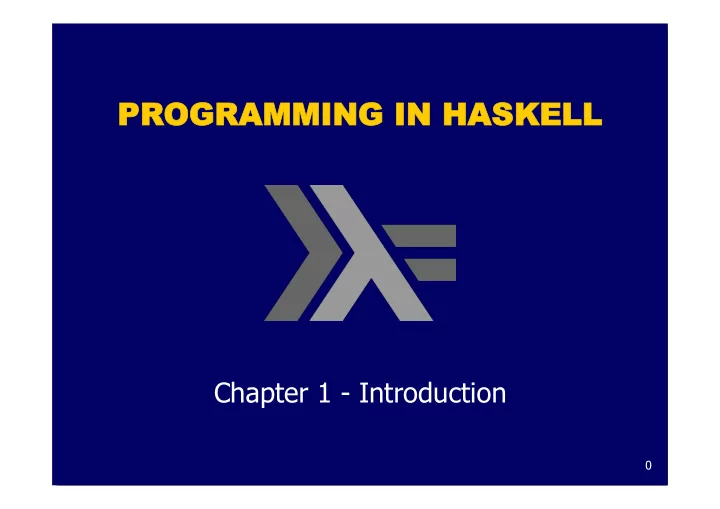

PROGR OGRAMMING NG IN N HA HASKE KELL LL Chapter 1 - Introduction 0
What is a Functional Language? Opinions differ, and it is difficult to give a precise definition, but generally speaking: ❚ Functional programming is style of programming in which the basic method of computation is the application of functions to arguments; ❚ A functional language is one that supports and encourages the functional style. 1
Example Summing the integers 1 to 10 in Java: int total = 0; for (int i = 1; i ≤ 10; i++) total = total + i; The computation method is variable assignment. 2
Example Summing the integers 1 to 10 in Haskell: sum [1..10] The computation method is function application. 3
Historical Background 1930s: Alonzo Church develops the lambda calculus, a simple but powerful theory of functions. 4
Historical Background 1950s: John McCarthy develops Lisp, the first functional language, with some influences from the lambda calculus, but retaining variable assignments. 5
Historical Background 1960s: Peter Landin develops ISWIM, the first pure functional language, based strongly on the lambda calculus, with no assignments. 6
Historical Background 1970s: John Backus develops FP, a functional language that emphasizes higher-order functions and reasoning about programs . 7
Historical Background 1970s: Robin Milner and others develop ML, the first modern functional language, which introduced type inference and polymorphic types . 8
Historical Background 1970s - 1980s: David Turner develops a number of lazy functional languages, culminating in the Miranda system. 9
Historical Background 1987: An international committee starts the development of Haskell, a standard lazy functional language. 10
Historical Background 1990s: Phil Wadler and others develop type classes and monads , two of the main innovations of Haskell. 11
Historical Background 2003: The committee publishes the Haskell Report, defining a stable version of the language; an updated version was published in 2010. 12
Historical Background 2010-date: Standard distribution, library support, new language features, development tools, use in industry, influence on other languages, etc. 13
A Taste of Haskell f [] = [] f (x:xs) = f ys ++ [x] ++ f zs where ys = [a | a ← xs, a ≤ x] zs = [b | b ← xs, b > x] ? 14
Recommend
More recommend